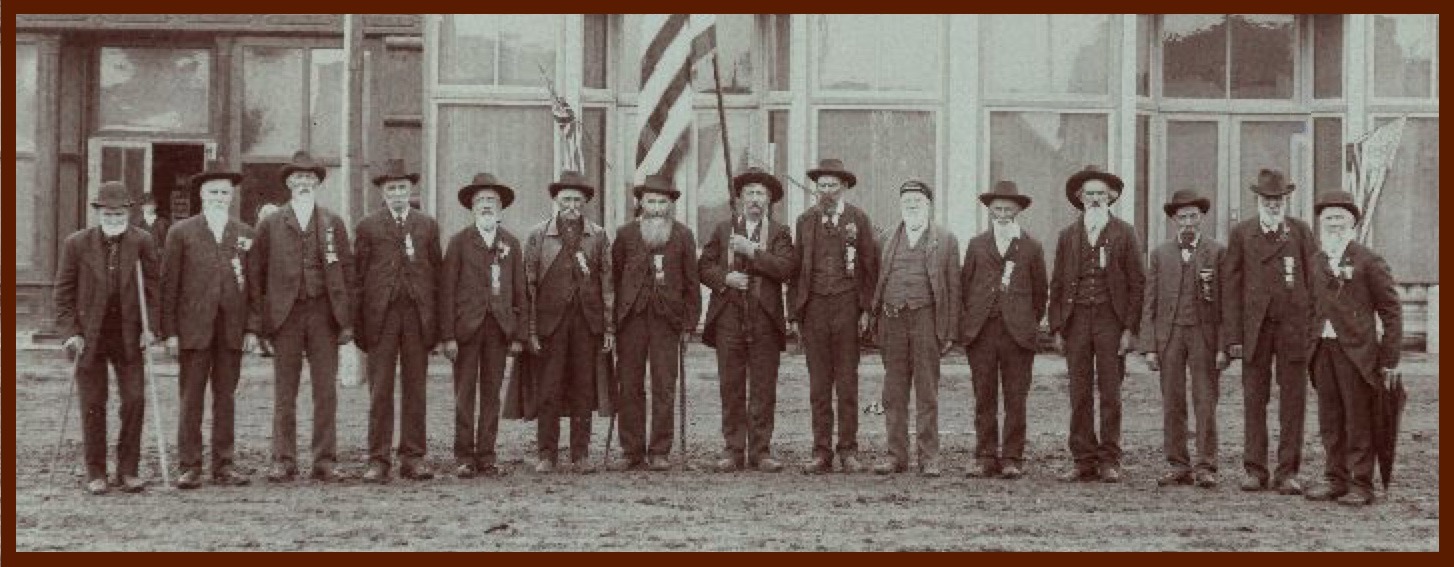The first time I saw the photograph showing members of J. J. Jones Post 226 assembled for review on the Main Street of Formoso, Kansas, was in 1986, when I was helping my mother assemble her book on the history of her hometown.
The picture didn’t strike me then as a relic from an ancient past. The buildings forming the backdrop for the Civil War veterans were exactly as I remembered them from my childhood. T. H. Shedden’s drug store is on the left, followed by the McCarthy Hardware building, with a bit of the Formoso Mercantile edging into the picture on the right (visible in the wider view on this album page). Names of veterans were attached to the photo, which had been contributed by descendants of one of the G. A. R. members, along with the helpful information that the picture had been snapped in 1900.

Jamison Wright, Edgar Walker, Joe Andrews, B. F. Clark, John Hamilton, John L. Worley, Josephus Canfield, William Patrick, John Clawson, Phyletus Axtell, N. M. Hyde, Julius Robinson, “Henry" Livingood, Jacob Baskin, and Mr. Johnson
However, it wasn’t until cousin Jim Dieckman emailed me a copy of the photo a few weeks ago that I took a renewed interest in studying it for whatever minute details might be revealed, and started cross-checking the roster of names with other records.
It became immediately apparent that the picture wasn’t taken in 1900 after all. The Formoso Mercantile wasn’t built until 1901, opening for business in the fall of that year. Neither could the year be later than 1907, when Phyletus Axtell, the gentleman in the cap, the second figure to the right of flag-bearer William Patrick, “died in harness,” as a local paper put it. Axtell, who seems built to be a blacksmith, must have labored over a forge for years, but had hung up his apron before 1907 when he turned 74. By that time he was a letter-carrier whose heart would give out one day on the last leg of his postal route.
G.A.R. records after 1903 list most of the men pictured here as officers of Post 226. Joseph Andrews, third man from the left, was not admitted to the group before 1906, but had lived in Formoso for years and might have celebrated the occasion with his fellow men-in-arms despite not being a dues-paying member. The leftmost figure, Jamison Wright, is notable for his lack of a lapel ribbon (nor does his name appear in local post records). He may have been visiting that day from Smith Center, where a J. A. Wright was not only a veteran but a firebrand populist editor of the Smith Center Messenger.
Seeing Wright and Josephus Canfield supported by canes and a crutch leads me to wonder if each man was also propped up by a wooden leg, a common badge of service among Civil War veterans. The man holding an umbrella is identified only as “Mr. Johnson.” There were two men named Johnson enrolled in Post 226, Joseph E. Johnson who died in 1903, and Ole F. Johnson, who is probably the man pictured here, a local celebrity known as the first bridegroom married in Jewell County, who also served two terms as Jewell County Sheriff. His accessory probably indicates that the street is as muddy as it looks, and the occasion is not a hot, dry 4th of July but Decoration Day, held at the end of May.
A number of the men pictured here survived the war to live especially long and productive lives. John Worley died in 1929, one month short of his 90th birthday. Northrop Mortimer Hyde moved to Republic where he lived until 1925, reaching the age of 86. Visitors to Caldwell Cemetery near Formoso might be impressed by dates on the headstone of Julius Caesar Robison, which indicate his age at death to have been 96 or 97. Robison’s birth year is given as 1829, which turns out to be the year his father was 13 years old and his mother was 6. Besides these obvious improbablities, the record of Julius C. Robison’s 1861 enlistment in the 2nd Iowa Cavalry lists the new recruit’s age as 20. Robison evidently died around the much-younger but still fairly remarkable age of 85.
Julius Caesar Robison, Northrop Mortimer Hyde, Josephus Canfield, and Phyletus Axtell may have boasted some of the noblest-sounding names in Formoso, but as with H. H. Livingood, G.A.R. records and newspaper items generally whittled them down to initials. Whoever wrote the note attached to the G.A.R. picture must have guessed that one of Livingood's “H’s” stood for “Henry,” although neither one did. His full name was Hindren Hinton Livingood.
As for when this photograph was taken, I’m leaning toward the last Decoration Day when it would have been possible, May 30, 1907. Phyletus Axtell still had a few morths months to live, while Joseph Andrews had only recently been accepted as a full-fledged brother at Col. J. J. Jones Post 226. Besides, the celebration in 1907 was a rainy affair, as the Formoso New Era’s brief report reveals.
A small audience attended the Decoration Day services the 30th, on account of the inclemency of the weather. Rev. Harrison talked war a little, told a few stories, preached prohibition and blamed God for the bad things and credited him with the good.